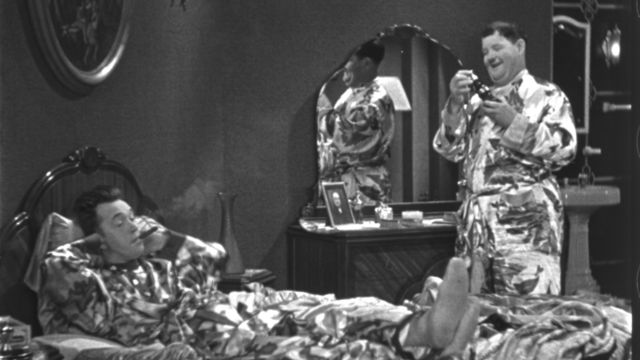
Scram! / Blondie
- This is a past program
Part of the UCLA Film & Television Archive’s 2022 UCLA Festival of Preservation screening series. Register at cinema.ucla.edu to attend this in-theater screening.
Scram!
U.S., 1932
While perhaps not as well-known as some of its more famous Laurel and Hardy siblings (Big Business, 1929; The Music Box, 1932), Scram! does offer its own particular brew of pre-Code delights and amusing mishaps. Shot shortly before the comedy duo went on an extended holiday to the British Isles and France (where they were mobbed by adoring crowds at every stop), Scram! is a somewhat subtler entry in the Laurel and Hardy oeuvre, although there are still plenty of “fine messes” for the boys to fall victim to.
As the tale begins, we find the hapless Stan and Ollie in peril as they stand trial for vagrancy. The judge (Richard Cramer), irate that there is no room left in his jail to lock them away in, reluctantly gives the penniless pair one hour to leave town—or else. As they head out, a well-intentioned—and hilarious—attempt to help an inebriated gentleman find his car key in the rain (Arthur Housman) instead starts them on a journey fraught with confusion and mayhem, ultimately ending in disaster when the boys find themselves trapped in a very compromising situation with the judge’s intoxicated wife (Vivien Oakland).
As with the best of the Laurel and Hardy films, we—the audience—find ourselves rooting for the boys to succeed with their naïve efforts to do the right thing, yet revel in their dimwitted antics when they fail in the most spectacular fashion possible. The UCLA Film & Television Archive is pleased to present another Laurel and Hardy restoration produced from its long-term initiative to preserve and promote the cinematic legacy of this legendary comedy team.
—Steven K. Hill
35mm, b&w, 21 min. Production: Hal Roach Studios. Distribution: Metro-Goldwyn-Mayer. Producer: Hal Roach. Director: Raymond McCarey. Screenwriter: H. M. Walker. Cinematographer: Art Lloyd. With: Stan Laurel, Oliver Hardy, Richard Cramer, Arthur Housman, Vivien Oakland. Restoration funding provided by Turner Classic Movies, Jeff Joseph/SabuCat, The Packard Humanities Institute and Laurel & Hardy Preservation Fund.
Restored by the UCLA Film & Television Archive from the nitrate original picture negative, a nitrate lavender master and the nitrate original track negative. Laboratory services by YCM Laboratories, Audio Mechanics, DJ Audio, Inc., Simon Daniel Sound. Special thanks to Richard W. Bann, Jeff Joseph, RHI Entertainment LLC.
Blondie
U.S., 1938
Blondie is the first film of 28 based on the iconic comic strip created by Murat Bernard "Chic" Young in 1930. The film follows the misadventures of the Bumstead family as they attempt to celebrate their fifth wedding anniversary. Dagwood (Arthur Lake) is sent by his boss, Mr. Dithers (Jonathan Hale), to get a new contract for their company, but instead he and another guest spend hours tinkering with the hotel vacuum cleaner. The titular Blondie (Penny Singleton) orders new furniture they can’t afford, suspects Dagwood of having an affair and asks for a divorce. Despite its light-hearted nature, the underlying plot of Dagwood’s attempt to get a fair wage from the stingy Mr. Dithers and avoid “camping on the porch of the poorhouse,” resonated with Depression era audiences.
While many actors and actresses were considered for the roles of Dagwood and Blondie, Arthur Lake and Penny Singleton became much beloved and continued to play these characters on the equally popular radio program and 1950s television series. Columbia used the films to showcase many of its contract players, including Rita Hayworth, Glenn Ford, Shemp Howard, Lloyd Bridges and, in this first film, Gene Lockhart, who played Bob Cratchit in A Christmas Carol the same year. In contrast to the stay-at-home Blondie, Penny Singleton was a liberal democrat, labor leader and served as president of the American Guild of Variety Artists, getting herself in hot water for labeling a fellow union officer “a dime store Hoffa.” Singleton testified to Congress on behalf of strip club artists and led the first successful strike by the Radio City Rockettes for better working conditions. King Features Syndicate, Inc. would later re-release the films on television with new main and end titles. The original animated credits have been restored and will be seen on the big screen in this series for the first time in over 50 years.
—Miki Shannon
35mm, b&w, 71 min. Production/Distribution: Columbia Pictures Corporation. Producer: Robert Sparks. Director: Frank R. Strayer. Based on the comic strip "Blondie” created by Chic Young. Screenwriter: Richard Flourney. Cinematographer: Henry Freulich. With: Penny Singleton, Arthur Lake, Larry Simms, Gene Lockhart, Jonathan Hale.
Restoration funding provided by The Packard Humanities Institute. Restored by the UCLA Film & Television Archive from a 35mm nitrate original picture negative, 35mm nitrate fine grain and 35mm nitrate print. Laboratory services by The PHI Stoa Film Lab, Audio Mechanics, Simon Daniel Sound.


